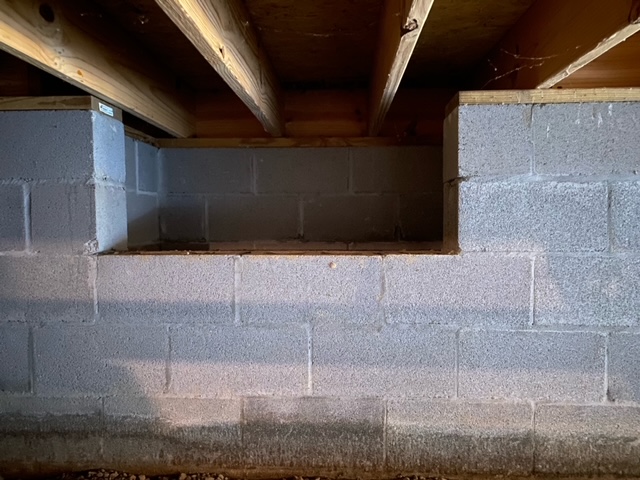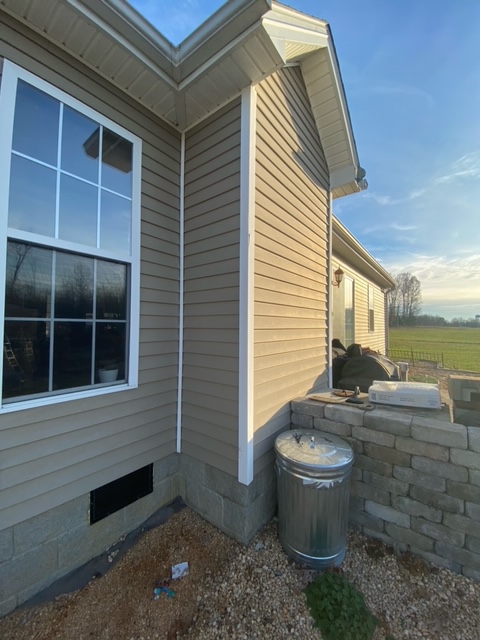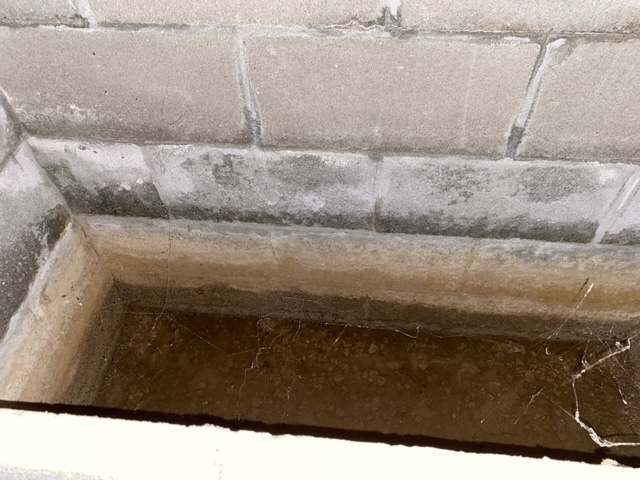What should we do to keep our crawlspace dry and prevent water from accumulating in the cistern-like structure built for the fireplace insert?
1 year ago
Last Updated: April 28, 2024
Hey there, could anyone lend a hand? So, we had our HVAC system taken out on Friday. The new one can’t go in until we lay down the crawlspace vapor barrier, but we’re not quite sure how to handle that. Seems like they built some kind of cistern for the ventless fireplace insert (check out pic 2). Picture one is on the opposite side of that wall, and it’s got about a foot of water just chilling there (see pic 3). We can pump the water out, but how do we keep it dry? We’re stumped because we can’t figure out where the water came from. No gutters, the ventless fireplace is unused, and there’s no leak from above. Is it normal to have something like this for a fireplace insert? Any advice would be greatly appreciated. Thanks a ton, everyone!



Living in an area with a high water table or close to a valley, underground spring, stream, or lake? Having gutters can be beneficial for any building.
Thanks for getting back to me! There are no lakes or streams nearby, and the land seems to be sloping away from the house. There is also no water pooling around the house. I’m puzzled about where this water is coming from. The rest of the crawlspace is actually dry!
Create a hole in the center of the cistern for a sump pump. Ensure there are gutters and drainage pipes to divert water away from the foundation.
Thank you, , for your response! We already have gutters installed at the ends of the house on all corners and near the garage. Are you suggesting adding more gutters in that specific area? How would you go about piping out the sump pump? Would it involve drilling into the cistern-like structure and piping it out?
In England, if your sewer drain is nearby, you could connect to it. Another option is to create a hole to the outside and run a pipe out, ensuring there is a slight downward slope along the pipe for proper drainage. Installing a check valve at the pump will prevent the pump from overheating in case the water flows back. Having gutters above the cistern area with drain pipes leading away from the house can be very helpful. Extending drain pipes away from the foundation all around wouldn’t hurt. Once the gutters are installed, the cistern should dry up. Applying waterproof mortar on the foundation wall and bottom of the cistern, along with a small water pump inside, can be a good idea.
In New Jersey, it’s against the law to drain a sump pump into the sewer line. I’m not sure about other places, but it’s definitely worth looking into.
In , where exactly do the gutters release the water? And how far away from the foundation of the house?
It seems that groundwater is seeping in because the ground level around your crawl space is higher than the backfill. The way the blocks are positioned, that specific area seems to be cut off from any drainage system that may have been in place.
On the ground level is consistently higher than the crawlspace backfill.
Isn’t always present
You’re absolutely right! It’s seeping in and the grade level is higher outside than inside. It seems like the builder of the house was using pseudo french drains to pass inspection by both the homeowner and inspectors! After witnessing the HVAC installation, no one would doubt that! It was awful! Now we are working on fixing all these issues and we’re not sure what to do with this area! Do you have any suggestions on how to fix it? Should we fill it with some dirt or earth material? Either way, thank you for your response!
I’m so sorry to hear that, it’s incredible how some contractors manage to get away with things. I live in an area with a high water table so crawlspaces are backfilled to above grade level since water follows the path of least resistance. Considering the amount of water you have, this seems like the easiest/best plan of action. The grade should also slope away from the foundation wall, not sure if this is a concern here. If it were my home, I would backfill with as much soil as possible, compact it in that area, then add 4 to 6 inches of sand to bring the level above grade, and finally finish with sealed 6 mil poly over the sand and up the block. I hope you have reasonably close crawlspace access.
Can you share a picture of the other side of that “retaining” wall?
My hunch is that they may have damaged the French drain around your house while installing it (likely crushed), which is why water is now seeping through at that spot.
If it were my house, I’d remove 3 feet of that wall and dig to inspect. If my theory is right, fixing it will be a small expense now and save you a fortune in the long run.
Once the repair is done, I’d also double-check the grading, as others have suggested.
Appreciate your input! The exterior wall can be seen in the second picture. Unfortunately, I don’t have a photo showing the wall that faces into the crawlspace. The so-called “retaining” wall is situated right in the middle of our house on an exterior wall at the back of the crawlspace. We did stumble upon this mysterious pipe sticking out of the ground – no clue what it’s for.
It’s possible that the area near or below ground level where water is seeping inside is due to the lack of sufficient water barriers on the chimney block line. It shouldn’t be a major issue, but it’s worth monitoring over time, especially during storms. You could try adding sand gravel to the cistern to help manage the moisture.
Would putting something in there cause mold to grow?
Suggest doing a test initially, there is currently no water present, but check it after storms, during them, and for over 3 wet months. If there is no significant water increase from the test, consider adding drainage sand to prevent standing water. The lack of drainage in the shaft is probably due to the concrete footer or clay, or both. By the way, if the area frequently accumulates water and enough of it, you may want to waterproof the outer layer of the chimney block wall. Use tar or a similar product on the exterior. Interior waterproofing is generally not very effective.
If it’s a newer home, there’s a chance that the plans included a cement structure to support the brick/stone.
I’d add some dirt to a few rows of blocks to level it with the house, then seal it during the main area work.
Do you think that could lead to the growth of mold?
You might find some moisture underneath the barrier, as it is designed to trap moisture below. So, yes, there is a possibility of mold, but it should stay contained.
Seems like Ryan’s homes were the ones behind it 😄
It’s very unlikely that an actual ‘cistern’ was built in this house. They probably just forgot or didn’t realize it needed a concrete base or floor.
Setting up a sump pump might be the most cost-effective solution to get rid of water accumulation.
I would definitely recommend consulting a basement specialist about this to check if the entire drainage system is functioning properly.
Having standing water in your situation is never ideal
This isn’t a cistern, it’s just a result of poor foundation planning by the original builder. Filling it in while still maintaining access for maintenance is likely the most cost-effective solution. Once that’s done, be sure to install a vapor barrier. Addressing standing water in the crawlspace now will prevent mold issues down the line.
I appreciate your response! Are you suggesting to fill it up with soil, sand, concrete, or rock?
Is planning to leave the water as it is in that area. I might consider using clay soil to prevent the water from seeping through.
Install a sump pit and pump. Surround it with concrete.
Are you suggesting we fill it in with concrete?
What I suggest is digging a sump pit into the soft ground there. Afterwards, pump out any remaining excess water and fill it with concrete. That should help.
It seems like they forgot to waterproof the outside of the picture as well. That could have prevented the water from getting in.
Can you explain what you mean by waterproofing?
Dealing with a damp crawlspace? Make sure water can reach the sump pump easily. Extend the 6mil vapor barrier from the floor up to the sill plate. If needed, consider installing a separate sump pump in a specific area and connect a hose to the main sump. Alternatively, waterproofing the foundation from outside in the problem area might be necessary. It seems like there isn’t any waterproofing above ground level…
What exactly is waterproofing? I don’t think we have any of that here haha!
Typically when the foundation is new and exposed, they either roll on a substance or apply a sheet material. The methods I have used to fix similar situations involve a two-part process. Start with a primer/tar layer and then add vertical sheets similar to bitchuthane, overlapping about 3 inches. In severe cases, we install a French drain along with vertical sheets of corrugated plastic with a fabric layer against the sealed foundation to direct the water into the French drain.
The concrete blocks around the small crawl space are the foundation for the chimney, holding up the walls that were framed as the chimney. In the photo showing the water, the concrete blocks look wet above them. Outside of this small crawl space, make sure to have a buried drain pipe to carry rain away from the house. Additionally, raise the ground around the chimney so water flows away from it.
My sister has her basement arranged in a way that mirrors the area under her chimney.
Just gotta get through those blocks or beneath the footer on that wall. There are a few different ways to tackle it. The good news is, it’s not a huge area. You can excavate around it down to the footer and apply a liquid waterproofing system or a membrane, or even both. Then, install a drain to divert water from the foundation, add gravel over the pipe, and backfill. Make sure the grade is highest at the wall, sloping down towards the yard. It doesn’t have to be a steep slope, just a gentle one of a few inches over a distance of about 10 feet.
It seems like there’s a water issue in the crawl space too, indicated by the staining on the block. The crawl space drains and the chimney area do not.
Waterproofing is typically not done on crawl space foundation walls, just on basement walls.
Usually, there’s a vent in the foundation wall below the fireplace to let air flow and dry up any water.